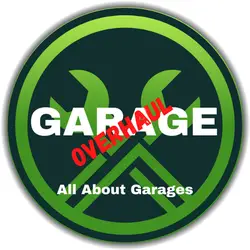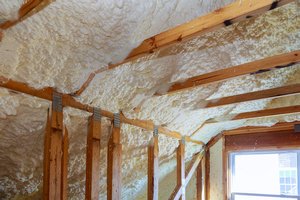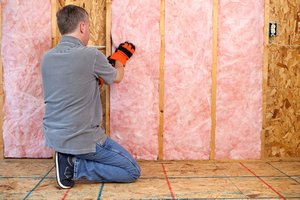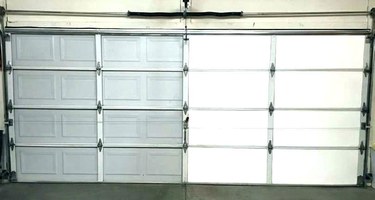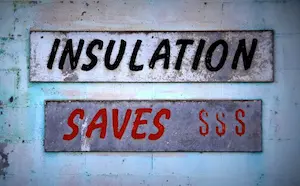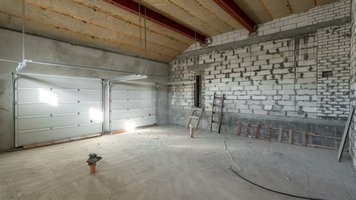Should I Insulate My Garage?
This post contains affiliate links.
It is widespread for garages to have multiple purposes. Some use them to keep their cars, while others use a garage for storage or recreational purposes. However, one thing can impact your ability to use your garage to its utmost purpose – the kind of insulation it has in its walls. Uninsulated garages can be uncomfortable and costly, so how can you insulate them?
Insulation is a process through which you can slow down the transfer of heat, particularly from the walls or the ceilings of your garage. This can help keep it cool in the summer and warm in the winter. Additionally, you can use many different kinds of insulation, and each one brings its own advantages and disadvantages to the table, depending on many factors.
Are you curious about what insulation can do for your home and garage? Do you want to learn precisely how the insulation process takes place and what benefits it brings to your home? In that case, you are reading the right guide! Through this article, we will explore everything you need to know before starting an insulation project for the walls of your home garage!
What Is Garage Insulation?
In most cases, the idea of insulation is similar inside the garage to the one you use within the inside of your home during the construction process.
This is a material that allows you to cover up the holes in the walls, through which cold air can come in during the winter, and warm air can escape during the winter months.
This helps to keep the temperature regulated. Garages often need insulation because of how they are placed. Since the garage is typically outside the house, they are more susceptible to bringing in the cold or warmth when it is unwarranted.
This can make the rest of the rooms in the house uncomfortable to be in, and it can add a lot of expense to your energy costs to keep the temperature in place inside your home.
The Benefits Of Insulating A Garage
You may be wondering – to insulate your garage, you will need to cause some mess and deal with many contractors. Why would you choose this? The answer lies in the benefits of insulation when it comes to the garage.
Ability To Use The Garage More
One of the most significant advantages of insulating the garage is that you won’t have to worry about it being too hot or too cold. You can use it more!
Many people use their garage space for things like a workshop, a gym, or even an office. With insulation, your garage will be a space you feel comfortable in, no matter the season or time of year.
Lower Energy Costs And Utility Bills
When your garage is insulated, the most significant benefit is that you can drastically reduce the cost of the energy bills you pay to keep your home at a stable temperature.
This is because adequate insulation can help cut the loss of energy, which means you have to spend a lot less energy to keep your home comfortable, especially if you don’t have an external garage.
Better Storage And Protection Of Items
If you have items in your garage that can get damaged because of humidity or extreme temperatures, then having insulation can keep those items safe.
For example, you will likely want to keep paints safe, so they are still available when you need them. You don’t have to worry about keeping your items in the garage and having them rust or go bad over time.
Improvement In The Resale Value
Another added bonus of an insulated garage is that having such a measure carried out makes your home much more attractive to potential buyers.
This is because this means the buyer will not have to undertake an expensive project, and they know that the quality of the home is good. So if you plan on putting your home on the market, insulation boosts the resale value.
Lower Noise Pollution From The Garage
Finally, an insulated garage is also great to help reduce the impacts of noise pollution. This is especially true if you live in a busy area and want to use the garage for other things, such as an office or an entertainment area.
Insulation helps to block noises from the outside and keeps the noise in. So if you want to keep the garage sound to a minimum, insulation is the way to go.
How Does R-Value Impact Garage Insulation?
When we start talking about insulation, one of the terms you will see coming up, again and again is the R-value.
It is normal to be confused about what this means, so let’s look at what the R-value indicates in terms of insulation. In general, the R-value measures insulation, describing how well each material gives you the effective insulation you need.
The R-value of any material can change depending on a number of factors, which include:
- the type of material
- the thickness of the material
- the density of the material
When you have a material with a high R-value, that means that it will be a better insulation tool. As a result, it will improve the energy efficiency of the garage.
That being said, R-value is not the only way to determine which material is best for your garage. Instead, it’s best to look at the options and consider factors such as your budget, the climate, and the area.
Read more in here what R-Value should you use in garages.
The Main Types Of Garage Insulation
As you saw in the section above, there are many different types of factors that impact what the right kind of insulation is for your garage.
Suppose you are about to undertake an insulation project for your garage. In that case, it is helpful to know what types of insulation are commonly used and decide on the right choice for you by considering their requirements, expenses, and efficiency.
Rigid Foam Insulation
The first type of insulation we will take a look at is rigid foam insulation. This material comes with a high R-value, and you will most likely find it in the form of sheets.
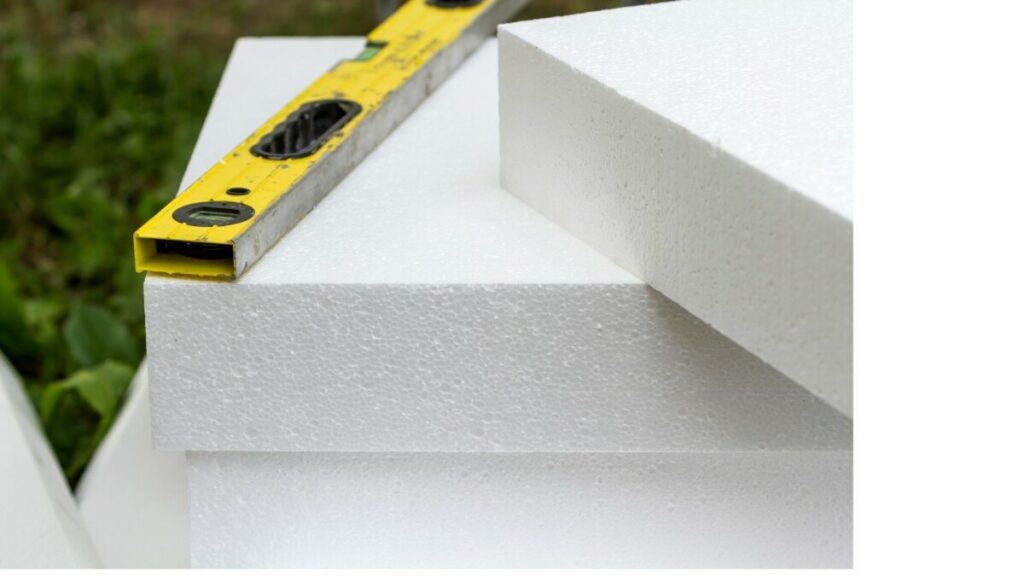
The thickness can range depending on the application you have for the rigid foam insulation. However, the most significant benefit of this kind of insulation is that it is not prone to moisture damage or splitting.
As a result, rigid foam insulation is an excellent choice for areas with higher humidity. However, the issue with this insulation is that it is best for doors and walls that are thinner in nature. Applying it to thick walls will be relatively complex.
That being said, the rigid foam insulation can be done by yourself, but it may not be the right choice for the garage wall.
Fiberglass Insulation
Fiberglass insulation is perhaps the most common type of insulation used when home insulation projects are involved.

This is especially the case for garages. This is because this type of insulation is affordable, effective, and relatively easy to install in the home. In fact, you can even probably install it yourself, although involving a professional is best.
Fiberglass is usually filled into spaces in the form of loose fill, which is then used to cover up any gaps in the garage’s walls. This will help to keep the space insulated and is generally low effort if you know what you are doing.
One option for garage walls is to use a plastic film to make the work look neater to avoid the catching of dust within the insulation over time.
Reflective Insulation
Next, reflective insulation systems use a reflection mechanism to reduce the heat in the space.
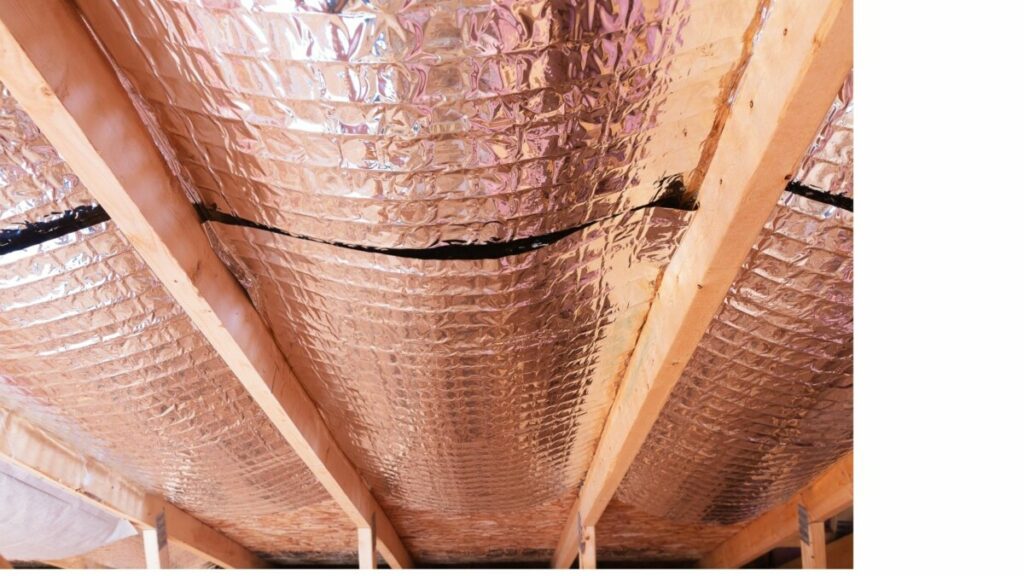
These systems are most useful in warmer areas where you need to keep the garage space cool during the summer, even without a central cooling system. Reflective insulation is not an effective way to keep spaces warm during the winter.
This kind of insulation is usually created using polyethylene or kraft paper. It is then wrapped up in a reflective aluminum foil to create a barrier.
The most effective use of this is either on a garage door or in the attic of your home. However, remember that this type of insulation will not be effective against the cold and is not really a proper ‘insulation’ system in that way.
Cellulose Insulation
Cellulose insulation is one type of insulation that has gained widespread interest because of its sustainable nature. This is made using recycled paper and treated to be resistant to fire.
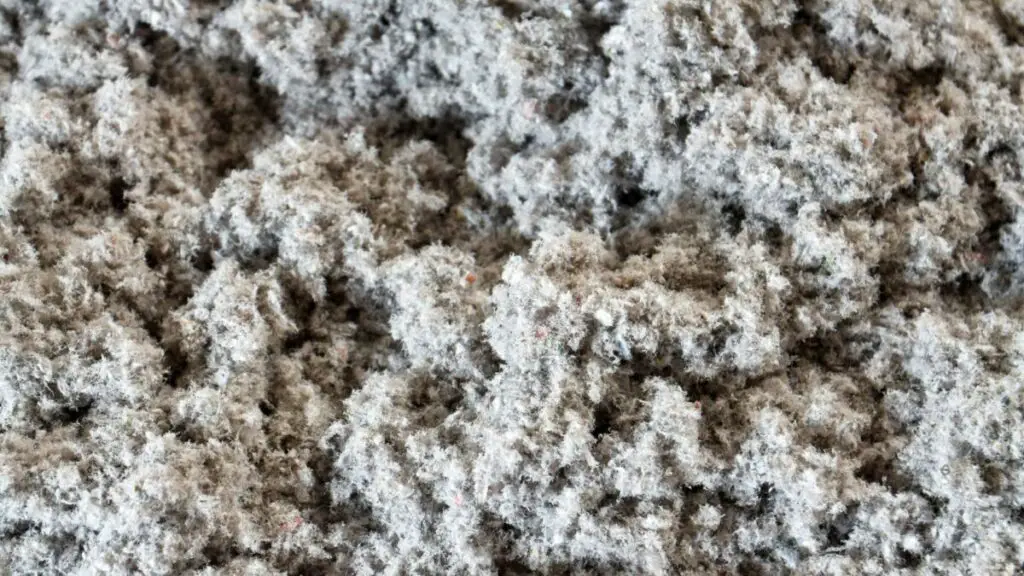
Then, it is a loose-fill material that is blown into a wall or a ceiling to fill up the space, keeping it cool in the summer and warm in the winter. This type of insulation is also DIY friendly!
The great thing about loose-fill insulation is that you can apply it to garage walls without increasing your carbon footprint.
However, keep in mind that it only works for finished walls and ceilings. To do this, you will need to cut out holes in the wall and use them to blow in the loose cellulose insulation. Finally, you can patch the holes, and the garage is insulated!
Spray Foam Insulation
Spray foam is an excellent choice if you are going for high-efficiency insulation. It comes with a high R-value, and it can completely seal the air and prevent major issues such as moisture damage and mold infestations.
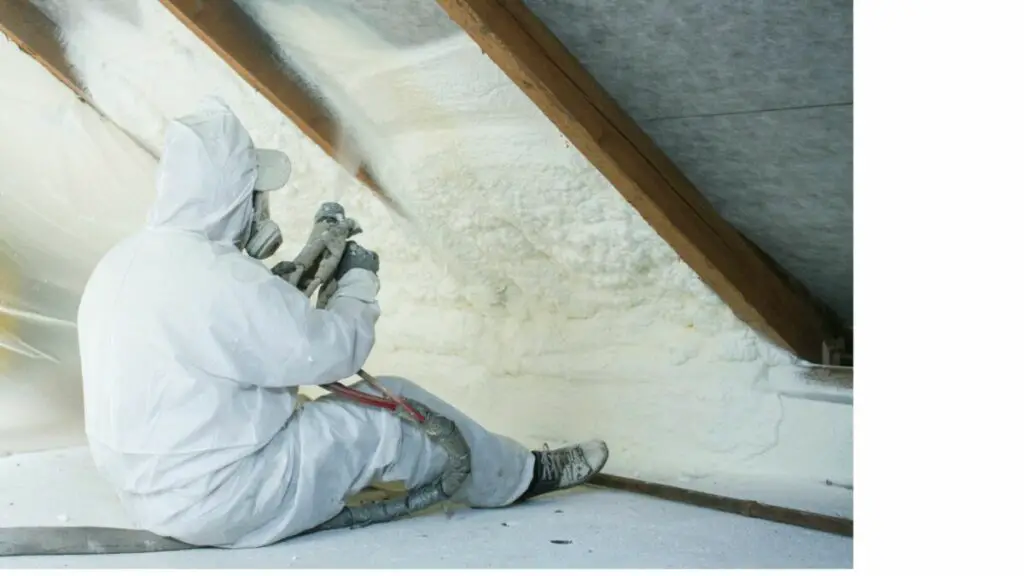
However, the problem with this type of insulation is that it can be expensive and is not DIY-friendly at all; in fact, it needs to be installed by a professional.
Using spray foam insulation is best in situations when you are planning to convert the garage in your home to a space for another purpose, for example, an office or a gym. That way, the expense can make sense.
That said, it can be a great choice when you want absolutely the best insulation material out there, even if it comes at a somewhat high cost.
The Tools You Will Need For A Garage Insulation
If you are ready to get started on an insulation project, the first thing is to choose the material you will be using. Once that is done, you can gather all the tools you will need in this process.
Here are some of the tools you can consider gathering before the project starts: (links to Amazon)
- A ladder to access higher areas
- Construction tape
- Utility knife and screws
- Measuring tape for accurate distances
- Hammer and drills
- A set of screwdrivers
- Safety accessories such as safety glasses and mask
- Staple gun and a sealant gun
- A vapor barrier and vapor tape
- Drywall and drywall screws
- Edging strips
Preparing beforehand and keeping all of these tools available is a great way to ensure your project goes smoothly. So you don’t have to take trips halfway through tearing down your walls. It will help ensure the process is seamless and efficient.
How To Stay Safe During A Garage Insulation Installation
When doing a garage insulation project yourself, there are some safety precautions you should always keep in mind to stay safe throughout the process. For example, one vital fact to consider is always wearing a face mask during this time.
A face mask is crucial, especially when you are working with loose fill insulation, as it will help prevent any damage to your lungs. A face mask can also help prevent dust and other dangerous items, such as mold, from causing damage.
At the same time, wear an eye mask to keep your eyes safe when cutting into the walls or blowing in insulation. Finally, it is always recommended to handle the materials in the insulation while wearing gloves to prevent injuries or damage.
Pointers For Garage Insulations
Aside from safety precautions, there are some further pointers you should always consider when you take on an insulating project at home, particularly for your garage. Here are some tips:
- Use scaffolding to ensure a safe environment and to get the most efficient results.
- Installing a vapor barrier will help protect the insulation from moisture.
- Do not cover up electrical boxes; leave space around them to keep them accessible.
- Remove hanging items from the walls before starting a wall insulation project.
- Seal any open cracks or holes in the wall before you add insulation to prevent mold.
- Keep any insulation away from lights, as this can cause a fire in some cases.
Now that you know what not to do when insulating, it is time to move further and discuss how to insulate your garage in the next section.
How To Insulate Parts Of Your Garage
So, if you have everything else under control, it is time to look at the step-by-step process of insulating your garage. Since the method can change depending on many factors, it is best to look at each project based on the area of the garage it concerns.
Insulating The Garage Ceiling
Starting with the garage ceiling, insulation can be a necessity in this area of the room if you want to minimize the amount of energy lost. Insulation in the ceilings helps you stay cost-effective, especially in the wintertime.
Warm air rises upwards, and insulation can help it stay there and keep the garage warm even when cold outside. Remember that you need an R-value of at least 38 for insulation in a garage ceiling. However, this number can change depending on your region.
Here are the steps you need to follow:
- Start by taking out your ladder and asking a friend to help you keep it in place.
- Measure the length and width of the ceiling, and then calculate the area.
- Similarly, measure the distance between joists and their depth.
- Cut out the area of the insulation that corresponds to these measurements.
- You can usually install the insulation to the ceiling with a staple gun.
- Cover any leftover areas with foam, or you can use some spray foam to cover the gaps.
- Finally, cover the ceiling space using either drywall or plywood, depending on your preference.
Read more in here what R-Value should you use in garage ceilings.
Read additional info and how to insulate the garage ceiling here!
Insulating The Garage Door
Similarly, applying insulation to your garage door is a very effective manner of keeping your space comfortable all year long. There are options for insulated doors in the market, but they can be pretty expensive.
However, installing insulation can be a little tricky in a door as it cannot hold the insulation in place as effectively as a wall or a ceiling can.
This means you may have to use other methods, such as retainer pins. Just keep in mind that the insulation must be much thinner and have an R-value between 18 and 12 to have a practical impact on temperature regulation.
Here are the steps you need to follow:
- Ensure that the door is completely clean. You can use a spray kit for efficient work.
- Use a measuring tape to check the height and width of the panels on your door.
- Cut out a piece of the insulation material that corresponds with these measurements.
- Create a landing space on each panel with two retainer pins for the insulation.
- Place the insulation onto the panel, pushing it onto the retainer pins.
- Push the pin cap over the pin, keeping the insulation in place.
- Repeat the same process on all of the panels of your garage door.
- Install weather stripping over the material to keep the door safe from the elements.
- Install a new seal on the door to keep it from letting in drafts.
- Test the door to make sure it can move smoothly as you use it.
Read additional info and how to insulate the garage door here!
Insulating The Garage Walls
Next, you can also insulate the walls in your garage if they are not already insulated. Having insulated garage walls are essential, especially if you have rooms in the house that share a wall with this space. That can change the feel of the entire home that is near the garage.
Fiberglass is often the insulation choice for garage wall insulation, but you have other options available. In most cases, the R-value for such insulation should be between 15 and 13.
Here are the steps you need to follow to insulate your garage walls:
- Make sure that all screws, hooks, and hanging objects are removed from the wall.
- Use a hammer or a screwdriver to pull all screws out of the wall.
- Find strategic areas to remove the covering off the walls where the insulation goes in.
- Make sure there are no open cracks in the walls, where water can cause mold growth.
- Seal any open cracks in the walls to prevent further damage, and let it dry out.
- Use fiberglass insulation that can fit into the wall, and push it gently inside.
- Cover the area with a vapor barrier that is secured in its place using a staple gun.
Read additional info and how to insulate the garage walls here and here!
Read more here how the finish the garage walls.
Insulating The Garage Floor
Many people may not consider floor insulation, but it can be necessary sometimes. While floor insulation is not exactly the required step for all garages, it is important for people who want to convert their space into a more workable and usable area of the home.
This will make energy loss minimal and will have a huge impact on how comfortable the space feels.
To insulate the garage floor, follow these steps:
- Cover the floor with the use of a vapor barrier. This will prevent moisture from entering.
- Add a layer of polyethylene to add even more of a moisture repellant on the floor.
- You can use rigid foam insulation in this area of the garage.
- Place this over the floor – it is best to use compression-grade insulation for this project.
- Cut the foam to the exact size of the floor, which you can do using a sharp knife.
- When the entire floor has been covered, you will need to cover it up.
- For this purpose, you can use a plywood base to cover the insulation.
- Add another layer of plywood, and then finish with your flooring choice.
Read additional info and how to insulate the garage floor here!
Read all about garage flooring in this series of articles.
How Much Does Garage Insulation Cost?
The insulation cost in your garage will depend largely on where you live and what type of insulation is used. Generally, wall insulation costs average between $300 and $800 per wall or attic, depending on whether there are two or three layers of insulation.
This means that a single wall will cost between $150 and $400. In comparison, an uninsulated garage with two walls may cost between $300 and $800 to insulate properly.
A number of factors can affect the cost of adding insulation to your garage. These include:
- Building Codes: Most cities require new buildings to be insulated. Suppose your garage was built before these standards were in place. In that case, you might need to hire an inspector who can check that the insulation has been installed correctly and determine what changes need to be made.
- Type Of Insulation: Fiberglass or cellulose are two of the most common types of insulation used in garages. Fiberglass is popular because it’s relatively cheap but not fireproof. At the same time, cellulose insulation offers a higher R-value that can help keep your garage warmer during winter. The type of insulation used will also depend on whether you are insulating the walls or ceilings of your garage.
- Hiring a professional: If you feel uncomfortable doing the work yourself, hiring a professional installer may be a good idea. They will be able to give you an estimate of the cost and check that the insulation has been installed correctly.
The bottom line is that garage insulation can help keep your garage at a comfortable temperature, which may also lower your energy bills and protect against moisture damage caused by condensation.
While it may prove to be an expensive investment, the average cost of this project can be lower if you do some research and choose a type of insulation that is right for your garage. Consider also pros & cons of insulation.
Final Thoughts
If you are thinking about adding insulation to your garage, several factors must be considered. These include the type and R-value of insulation you want to use, whether building codes require it in your area and whether you would prefer to complete this project yourself or hire a professional installer.
Although garage insulation can be expensive, it can offer significant benefits in terms of comfort, energy efficiency, and protection against moisture damage. So if you are ready to start insulating your garage, do your research, plan ahead, and get started today!
Read also other article on how and why insulate your garage here.
